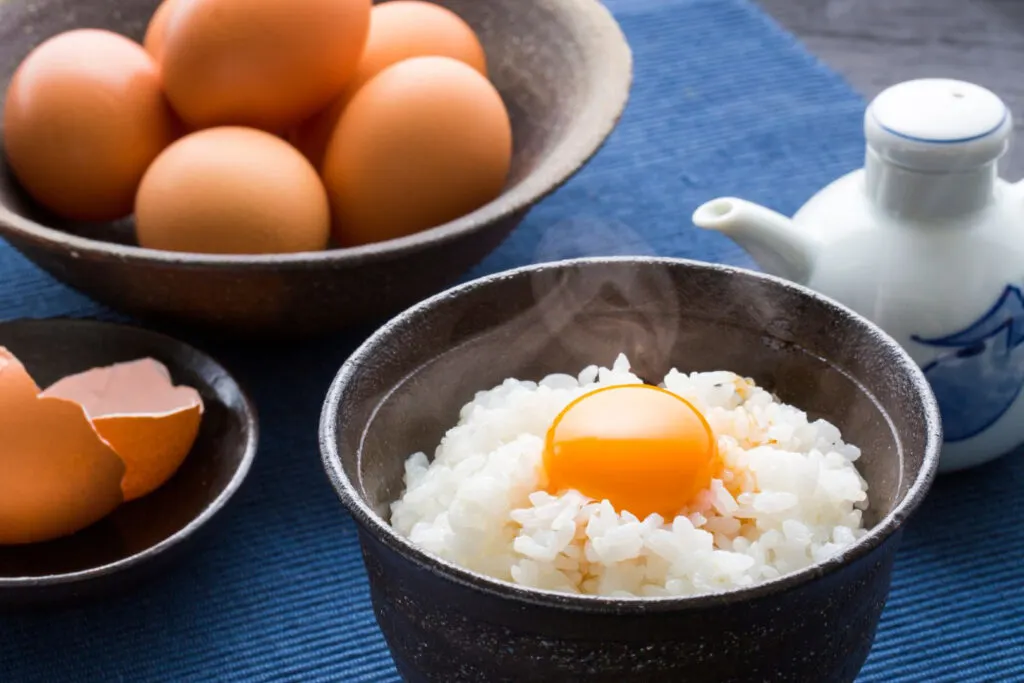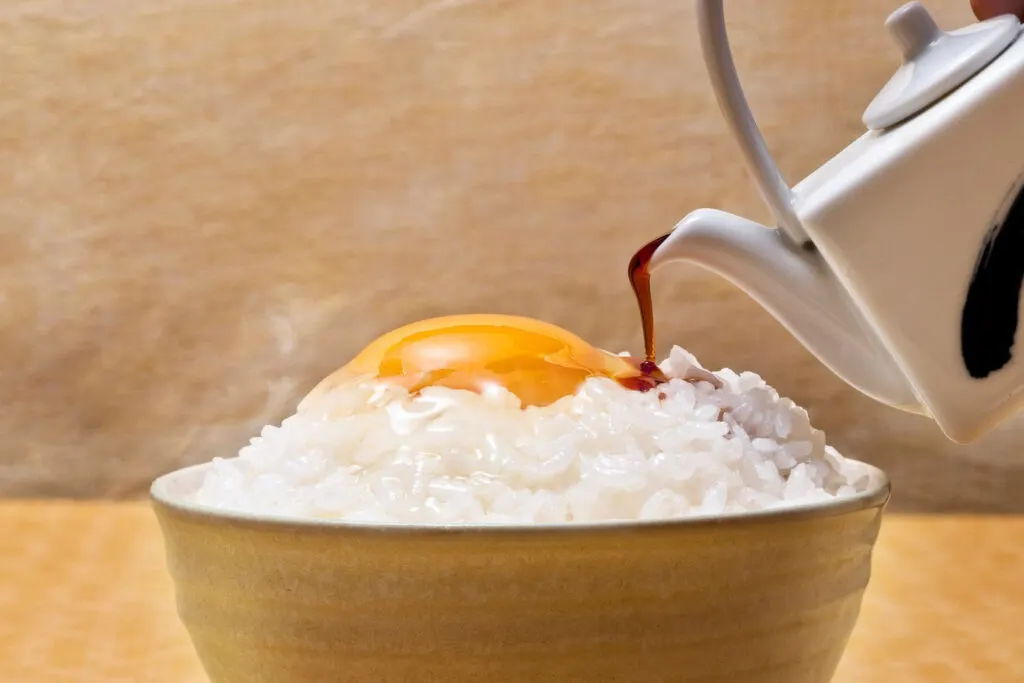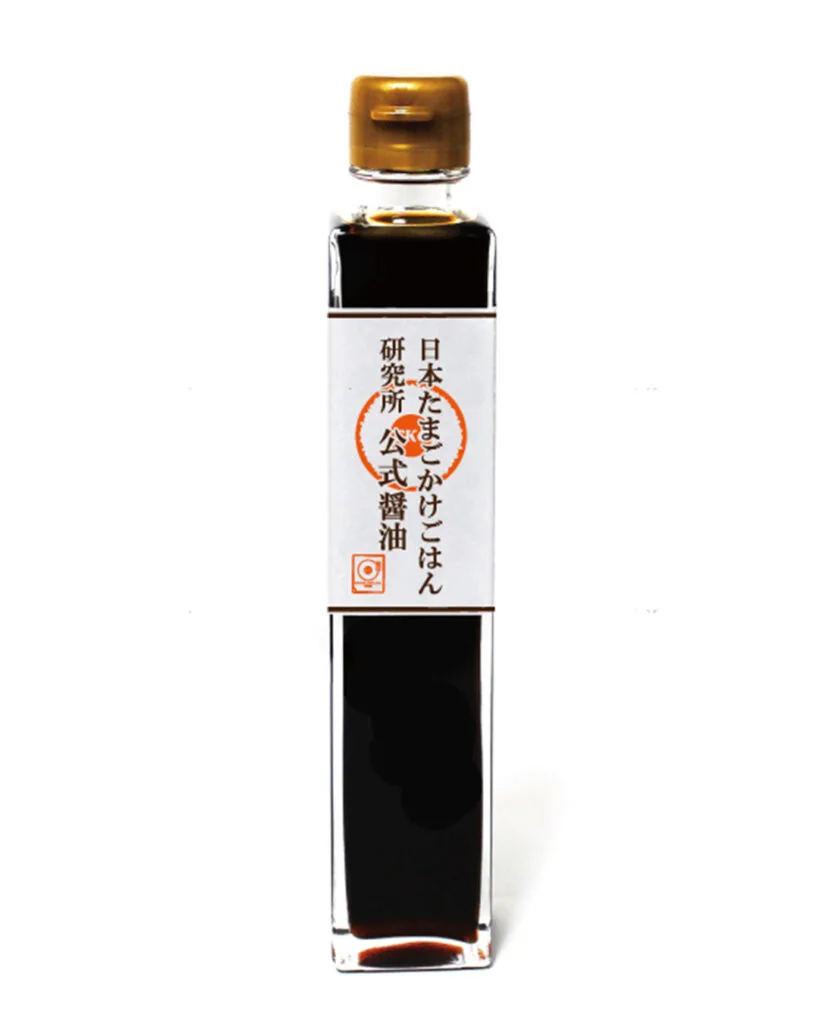Tamago Kake Gohan (卵かけご飯, たまご・かけ・ごはん), commonly referred to as TKG, is raw eggs over rice. This seemingly simple dish is a very popular breakfast in Japan and is frequently discussed online and in Japanese manga and anime. There is even a TKG Research Institute, TKG festivals…Japanese people take their Tamago Kake Gohan seriously!
The idea is very simple: you crack a raw egg onto a hot bowl of white rice, and drop a few drops of soy sauce on top for flavor. In such a simple dish though, the quality of the components become important – a perfectly-cooked bowl of white rice, good eggs, quality soy sauce…In fact, there are some special eggs and soy sauces developed specifically for TKG. Not to mention the endless possibilities for adding toppings.

Here is a list and illustrations of different ways to enjoy Tamago Kake Gohan, developed by the TKG Research Institute, which we will talk about later in this article. With creative names like “Flying Nimbus” (mix the egg yolk and egg white into a meringue like state and mix with rice, then drop a few drops of soy sauce) and the “Dark Side” (place the egg yolk in soy sauce for one night and place that on top of rice), you’re sure to find new ways of eating Tamago Kake Gohan. Read until the end to find out my personal favorite way to eat TKG!

Table of Contents
Ingredient 1: Eggs; is eating raw eggs safe?
Some of you may be asking, is it safe to eat raw eggs (生卵, なま・たまご)? The short answer is, yes, if you are in Japan. Eggs sold in Japan are sold with the premise that they will be eaten raw. There are much fewer cases of salmonella poisoning in Japan compared to outside of Japan, only 318 people got salmonella in 2021, and when it does happen it is mostly due to it being spread in restaurants in the kitchen from other sources rather than fresh raw eggs being the cause.
The reason why it is safe to eat raw eggs sold in Japan is that Japan has very strict hygiene standards and quality control when it comes to egg production. It starts from the feed given to young chicks, which is controlled under the “Feed Safety Law”. Once laid, eggs are collected and sent to a factory that sorts, washes, and checks and packages eggs using special machinery. Any eggs that have blood spots or cracks are eliminated at this stage. Furthermore, the best-by date on Japanese eggs is set so that it is safe to eat raw before this date.
In recent years it has become more common to find free-range eggs in supermarkets as well, which is preferred by many from an animal-rights perspective as well as the quality of the eggs. The word for free-range eggs is 平飼い卵 (ひらがい・たまご, Hira-gai tamago), which you can find on the packaging of the eggs.

Ingredient 2: Rice; how to make great rice
So now that we have learnt about eggs, the next ingredient in question is rice. There is so much to say about Japanese rice, but I’ll try to keep things short here. White rice is a staple food in Japan, and Japanese people have a lot of opinions about it. They are so opinionated that they are willing to pay top prices on home-grown rice, and pay even more for premium brands.
Some of the more famous brands are Koshihikari, Akitakomachi, Hitomebore and Tamanishiki. The name of the rice will also have the area it is grown in. Niigata and Akita are famous for their rice, and it is said that having a high difference in temperatures produces better rice.
When it comes to cooking rice, most homes in Japan have rice cookers, and with a few basic pointers it’s not difficult to make great rice at home! Basically all you need to do is measure the rice, wash the rice and turn on the rice cooker.
In Japan, rice is measured using a unit called 合 (ごう, Gō), which is the equivalent of 180ml, and Japanese measuring cups will typically have lines for this unit alongside 1 cup. There are usually lines in the rice cooking machine’s bowl that correspond to the amount of water required for each gō as well so you just fill it up until there.
If you don’t have a rice cooker like this, for every 180ml of rice, you want to add 200ml of water. I find that a 1:1 ratio produces rice that’s too hard or dry, so I recommend either soaking the rice in water for 20 minutes, or if you’re impatient like me, just adding an extra 10-20% more water.
It is common for white rice to be no-wash rice, or 無洗米 (むせんまい, Musen-mai) which means you can skip the step where you rigorously wash the rice. I still give it a few rinses before I put it in the rice cooker.
Then you switch on the rice cooker and cook the rice. Once cooked, I wait for 5-10 minutes for the rice to steam and settle (unless I’m desperately hungry), then fluff up the rice using a wet shamoji (rice paddle). “Fluff” is the key word here, you do not want to crush the rice grains. It is said that good rice should not be too soggy nor too dry, shiny and the rice grains should “stand”.
Ingredient 3: Soy sauce; quality soy sauce
Soy sauce (醤油, しょうゆ, shōyu) is probably one of the most well-known of the essential condiments in Japanese cuisine. Although outside of East Asia the types of soy sauce available on the market may be limited, investing in higher quality soy sauce is a good idea for dishes where the taste of the soy sauce can make or break the dish.

There are various factors that distinguish certain soy sauce from others.
- The color of soy sauce – there are different colors and thicknesses in soy sauces. Shiro Jyōyu or white soy sauce, Usukuchi Jyōyu or light soy sauce; Amakuchi Jyōyu, a sweet soy sauce used in Kyushu and Hokuriku areas; Koikuchi Jyōyu which is dark and the most common type of soy sauce, Saijikomi Jyōyu or soy sauce that has been matured, and Tamari Jyōyu which is the thickest and darkest soy sauce made with less water and more soybeans.
- Soy sauce made from skimmed processed soybeans and soy sauce made from whole soy beans – although people assume whole soy beans will make higher quality soy sauce, this is not always the case. Skimmed processed soybeans can produce soy sauce with higher concentration of umami, while for whole soybeans, it is easier to trace where the soybeans were made.
- Soy sauce with added alcohol – sometimes alcohol is added to soy sauce to compensate for lower salt levels and in order to make the shelf life longer. It is not necessarily a bad thing, although if you are trying to avoid alcohol, you may want to check the ingredients.
- The amount of salt water added to the soy sauce – in order to adjust the salt levels and color, salt water may be added to the soy sauce. The more salt water added, the less umami concentrate there is in the soy sauce.
- Soy sauce made in wooden barrels – traditionally soy sauce was made in cedar wood barrels called 木桶 (きおけ, Kioke). These days most commercial soy sauce is made in metal tanks which can better control the quality of the soy sauce. However, soy sauce made in wooden barrels is making a comeback as the soy sauce made this way is more interesting and reflects each of the soy sauce maker’s unique properties, much like whiskey or wine.
Here are some soy sauces recommended for using with TKG, selected by Shokunin Shōyu, a soy sauce shop that sells 100 different types of soy sauce from around Japan in small 100ml bottles.
Tamago Kake Gohan toppings
If you’re wanting to add something extra to your Tamago Kake Gohan, toppings provide an easy way to change things up, and give even more variety to the already many ways to serve your rice, eggs and soy sauce.
Common toppings include nori seaweed, furikake (a dry seasoning sprinkled over rice), nametake (the slimy mushroom in a jar), tarako (cured cod roe), mentaiko (spicy cured cod roe), goma (sesame seeds), katsuobushi (dried bonito flakes), rāyu (chili oil), negi (scallions, spring onions) and shiso (perilla leaf).
However there are really no hard and fast rules, so feel free to experiment with your favorite flavor combinations.

TKG Research Institute and official soy sauce
Yes, a group of Japanese enthusiasts decided Tamago Kake Gohan is an important enough matter that they created a “TKG Research Institute”! Indeed they do take things seriously; the people over at the TKG Research Institute tried more than 300 types of soy sauce to find the best suited for TKG, and developed a specially tailored shōyu.

Takafumi Ueno, the representative director and founder of TKG Research Institute is a chef, food educator and event producer, and through the activities of the TKG Research Institute he hopes to not only research different ways of eating TKG but also to help farmers and producers, help with regional revitalization through creating local TKG maps and events, and to promote Japanese food culture.
Tamago Kake Gohan Festival
For those of you in and around Tokyo in fall (autumn), there is an all-you-can-eat Tamago Kake Gohan festival. Back for its second iteration after a two year hiatus due to the pandemic, this year’s event is titled “Egg Fes in Ikebukuro 2022” and will be held from the 21st until the 23rd October at Ikebukuro Sunshine Exhibition Hall.
This event is held by the TKG Research Institute in support of egg businesses and for just 500 yen (less than US$5), you can gorge yourself on as many of the 60,000 eggs (60 brands), 30 different types of soy sauce (in classic wooden barrels) and the 1 tonne of rice on offer as you can.
The Phantom Egg Shop
The TKG Research Institute is also running pop-up shops in stations and event spaces around Japan. At the Phantom Egg Shop you can purchase several different types of premium eggs and the TKG Research Institute official soy sauce, as well as toppings. They also sell TKG goods made by the Institute, such as t-shirts and tote bags.
See the upcoming schedule of the Phantom Egg Shop pop-up here (Japanese only).
Have you heard of Tamago Kake Gohan? Have you had TKG before? What is your favorite way of eating TKG? Let us know in the comments!
My favorite way to eat Tamago Kake Gohan: Personally I like a few drops of sesame oil along with the soy sauce and I also like to sprinkle some Korean Jaban seaweed flakes (Korean nori seaweed flakes fried and flavored with sesame oil and salt) on top of the egg and rice.
Pin me for later

Madoka Suganuma is a freelance qualitative market researcher and a cultural insights analyst based in Tokyo with an expertise in Food & Beverages.
Having split her time between Europe and Tokyo in her formative years, Madoka is on a mission to uncover and provide insight into Japanese culture and people. Madoka enjoys learning about different cultures through food and hopes that readers can have fun learning about Japanese food culture through Japanese Food Guide.

joal
Thursday 16th of February 2023
Thank you for sharing this! My daughter learned of tkg from a friend and was saying how much she loves it so I wanted to try it. I appreciate all of the info you've included besides the recipe - so interesting!